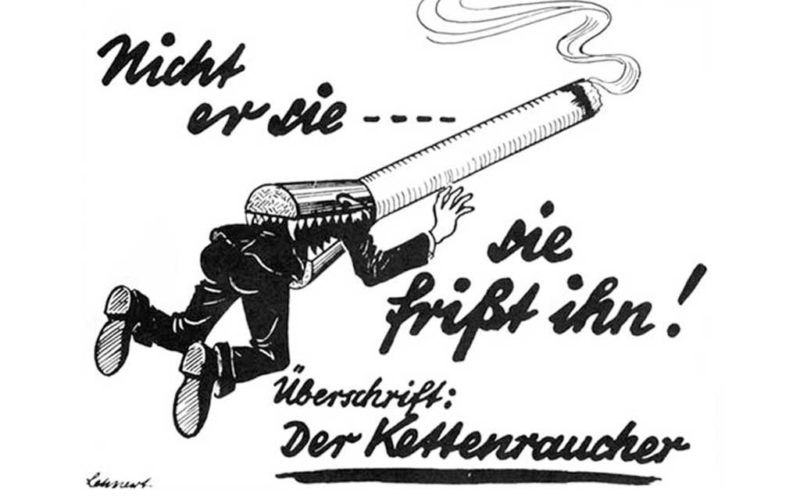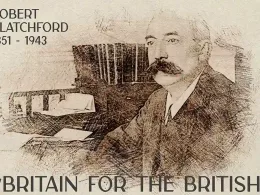Main Image: The chain smoker: “You don’t smoke it – it smokes you!”
The complete blackout of anything positive about National Socialist Germany continues to this day, over 75 years since the end of the Second World War. The mass of our people still believe in the lies that were made up during the war and repeated, almost daily, ever since. This speaks volumes about our ‘leaders’ and how they were/are willing to pretend nothing good or beneficial came out of Germany no matter what the cost.
Unfortunately, the cost has been the many, many thousands of ruined lives across Britain and indeed the world, each statistic made up of personal tragedies. Pioneering research was simply discarded or ignored because it came from ‘them’. Findings that today seem to be obvious were then seen as revolutionary.
LUNG CANCER AND TOBACCO CONSUMPTION
According to an article in Toxicological Sciences, before 1900, lung cancer was extremely rare worldwide, but incidents of the disease increased dramatically by the 1930’s. This coincided with the growing popularity of cigarette smoking beginning toward the end of the 20th century
The first ever case-control study of smoking and lung cancer originated in Germany in 1939*** and found that heavy smoking was strongly related to the risk of lung cancer. Research by German doctors also brought to light the harmful effects of secondhand smoke for the first time, and coined the term “passive smoking.”
In 1943, a paper prepared by German scientists Eberhard Schairer and Erich Schöniger** at Jena University confirmed this study, and convincingly established for the first time that cigarette smoking is a direct cause of lung cancer.
THE CAMPAIGN AGAINST TOBACCO
National Socialist Germany launched the first and most broadly reaching anti-smoking campaign of modern times. Smoking was discouraged in the workplace, and banned in cinemas, and in schools. Policemen and servicemen could not smoke in uniform, and it was not permitted to sell women cigarettes in cafes and other public places. Advertising tobacco products was restricted.
German research was among the first to suggest that smoking mothers’ breast milk contained nicotine and that smoking while pregnant causes a higher rate of stillbirths and miscarriages.
To encourage people to quit smoking, the researchers suggested “psychological counseling, nicotine gums, methods to make cigarettes distasteful using silver nitrate mouthwash, and injections (of a chemical) that bonded with compounds in tobacco to produce a disagreeable sensation.”
TIMESCALE OF THE FINDINGS AND ACTIONS TAKEN
- The first ever case-control study of smoking and lung cancer published in Germany in 1939. It concluded that heavy smoking was strongly related to the risk of lung cancer.
- Dr Leonard Conti, the Reich health leader, established the Bureau against the Dangers of Alcohol and Tobacco in 1939.
- In 1939 Hermann Göring issued a decree forbidding the military from smoking on the streets and during marches or brief off-duty periods.
- In 1942 the Institute for the Struggle against the Dangers of Tobacco was established at the University of Jena, where a second case-control study of smoking and lung cancer was carried out (this was a thorough investigation in which the authors showed a sophisticated understanding of the potential biases that could distort epidemiological findings. The institute from which this study was run was supported by a donation of 100,000 reichsmarks donated personally by Adolf Hitler).
- As well as research on smoking there was much anti-smoking health promotion in Germany at the time.
- The Hitler Youth and the League of German Girls helped disseminated anti-smoking propaganda.
- In 1942 the Federation of German Women launched a campaign against tobacco and alcohol misuse.
- Smoking was banned for both pupils and teachers in many schools.
- From July 1943, tobacco use was outlawed in public places for anyone aged under 18 years.
- It was considered criminal negligence if drivers were involved in crashes while smoking.
- In 1944, smoking was banned on trains and buses in cities. It was also prohibited in many workplaces, public buildings, hospitals, and rest homes.
HEALTH PROMOTION
- The consumption of alcohol was also strongly campaigned against.
- Fruit and vegetable consumption was encouraged, as was the use of wholemeal bread and the avoidance of fat.
- A key figure in German medicine, Erwin Liek, predicted that cancer would come to be seen as a product of diet.
- A 1942 health manual proclaimed “mothers, you must absolutely avoid alcohol and nicotine during pregnancy and when nursing. They hinder, they harm, they disrupt the normal course of pregnancy. Drink fruit juice.”
- The carcinogenic effects of food dyes came under scrutiny, as did the radiogenic lung carcinomas of uranium miners caused by exposure to radon gas.
- Research was also conducted into the perils of mercury dental fillings, and the carcinogenic impact of asbestos. By 1939, occupational authorities were routinely listing lung cancer as one of the occupational hazards of exposure to asbestos dust.
CONCLUSION
It took nearly a decade after the end of Second World War before the American Cancer Society published studies that confirmed the link between lung cancer and smoking, and the risk of second-hand smoke. In 1971 British epidemiologist Sir Richard Doll was credited with and knighted for his research making similar ‘discoveries’ about the link to cancer from tobacco use.
Modern Germany (as anyone who has visited recently will attest to), has one of Europe’s worst records in the area of tobacco control, this despite being home to some of the world’s first tobacco epidemiology. European and American tobacco companies have both tried to play the Nazi card, associating smoking restrictions with Nazi-like policings.
A case of ‘never mind the cost in cancer, heart disease, stroke, lung diseases, diabetes, and chronic obstructive pulmonary disease (COPD), which includes emphysema and chronic bronchitis, think of the profit.
*In 1939, German scientist Franz Müller presented the first epidemiological study linking tobacco use and cancer.
- *Müller FH. Tabakmissbrauch und lungencarcinoma. Z Krebsforsch 1939.
- Proctor RN. The Nazi War on Cancer. Princeton: Princeton UniversityPress, 1999.
- Proctor RN. The Nazi War on Cancer. Princeton: Princeton UniversityPress, 1999.
- **Schairer E, Schöniger E. Lungenkrebs und tabakverbrauch. Z Krebsforsch 1943.












